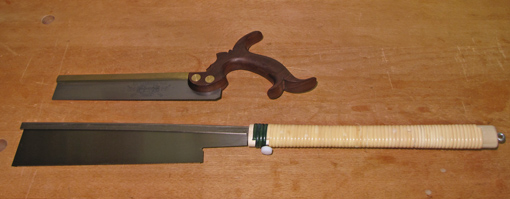
A reasonable, basic set of saws for furniture making consists of joinery saws for dovetails and tenons, small to medium crosscut saws for general work and shoulders, and big handsaws for crosscutting and ripping boards. There are many other good approaches to the basic saw kit that are used effectively by excellent craftsmen. There is no single “right” way! For example, the late, great teacher Tage Frid used his Danish rip-sharpened bowsaw for everything from dovetails and tenons to ripping and crosscutting boards.
My saw kit has evolved over many years and this will doubtless continue. I think, however, that I am now comfortable enough with my arsenal that I would like to share my approach with readers. It includes both Western and Japanese saws, with some redundancy, because I like both styles. It does not bother me a bit to go back and forth between the two. While I would not advocate that all woodworkers take my one-world, kumbaya approach, I vehemently disagree with those who contend that East or West is definitively better. They are simply two highly evolved, effective methods of sawing wood and you can make wonderful furniture with either if you get good quality tools matched to their function.
The discussion will not include the many other saws, some essential, some specialty, such as flush cut, keyhole, coping, turning (bow), fret, chain, hack, and veneer saws. No seesaws either.
Let’s start with dovetail saws:
1. Gramercy dovetail saw. Gee, I love this tool. 9″ canted blade, 0.018″ saw plate, 19 ppi beautifully sharpened and hammer-set rip teeth, zero rake, 0.003″ set each side. $149.95 from Tools for Working Wood. This is a light, smallish saw that starts easily and cuts smoothly. It is perfect for drawer making but also can do larger casework dovetailing. For current (or former) Japanese saw users, it is a natural transition. In fact . . .
2. Hishiki rip dovetail saw. 9 ½” blade, 0.012″ saw plate, 19 tpi true rip teeth, set about 0.002″ each side. $42 from Japan Woodworker, item #07.116.240. Replacement blade $28. I feel this is an Eastern cousin with the convenience of an inexpensive replaceable blade. Please don’t use a crosscut or hybrid (ibara-me or nezumi-ba) tooth dozuki for cutting dovetails, which involves essentially rip cuts. They tend to wander in the rip cut, and are so slow that you cannot tell if you are tracking the line with each stroke. Wrong tool for the purpose. I have tried more expensive Japanese dovetail saws, though not those in the several hundred dollar range, but I now prefer this low priced Hishiki.
Yes, these two saws are mostly redundant. They both start well, track well and are reasonably fast. Frankly, the difference for me mostly comes down to a different feel and vision in following the line. The Gramercy pushes sawdust away from me and is a bit more responsive in tracking the line, while the Hishiki is more fastidious in requiring accurate starting strokes. The pull-cut can drag enough sawdust to partially obscure the line unless I exhale strongly – ahh, the Zen of it all. Contrary to what is often stated, the thinner kerf does not increase accuracy. A clean-sided kerf increases accuracy and both of these saws produce that. Really, some days I just feel better with the Japanese saw but if I could have only one, well, it’s the Gramercy.
But it’s my shop and I get to have both. So take your pick(s) – they both work – and go make something.
Next: tenon saws.

